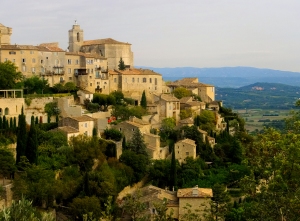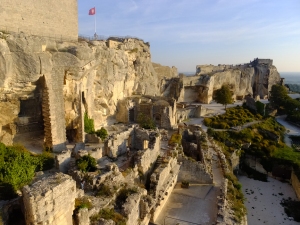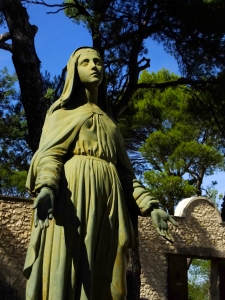Tags
Alpilles, Beauregard, bocce, Bonnieux, Boules, Chapel de Beauregard, France, Glanum, Gordes, Hill Towns, Jean Moulin, L'Echauguette, Les Baux, Luberon, Mont Ventoux, Muslim enclave, Oppède-le-Vieux, Orgon, Our Lady of Beauregard, Our Lady of the Assumption, petanque, Plane trees, Provence, Saint-Rémy
Of all the places we visited in France, Provence was the most wonderful. In Provence, you can see and touch and walk among the artifacts of history, both ancient and recent. You can walk where Van Gogh walked and visit the places where he suffered. His paintings come to life, giving a new understanding of what makes this artist so special. All this in a setting of unsurpassed natural beauty and a historic quaintness that is unique to Provence. There’s too much to cover in one blog post, but let’s get started.
Click on an image to see it larger, then click your back button to return.

Every road in Provence leads to a new wonder. Plane trees near Saint-Rémy-de-Provence make the road a magical tunnel.

Provence is justly famous for its hill towns. Originally sited on high peaks for defensive purposes, they now provide us with picture-postcard views. This one is Gordes.

Remnants of the once-mighty Roman Empire can be seen all over Provence. These ruins are what remains of the Roman triumphal monuments of Glanum, near St. Remy.

And looming above it all is Mont Ventoux, the “Giant of Provence.” We had enjoyed watching on television as cyclists climbed this behemoth in the Tour de France. Seeing it in person gave us a new appreciation of what it means to race up such a mountain on a bicycle.
Orgon
As our base in Provence, we chose the little-known village of Orgon. It is well-situated in the center of Provence, in the middle of the triangle created by the more famous towns of Arles, Avignon, and Aix-en-Provence.

Our apartment was right on the town square, across from the Hotel de Ville (as “city halls” in France are called). This is the night view from our porch of the Hotel de Ville and Our Lady of the Assumption church.

Here I am resting at the fountain near the cave. The cave is used to store the town’s landscape maintenance equipment.

As in much of France, the memories of the losses inflicted by the Nazis in World War II are memorialized. Here many of the streets were renamed after ordinary citizens who lost their lives in the war.

Orgon — like almost every town in France — remembers the famous French Resistance leader Jean Moulin. This monument overlooks a small contemplative garden dedicated to the memory of those who resisted the Nazis in occupied France.
Boules Tournament

The object of boules is for one of your team’s heavy steel balls to wind up closest to the little white target ball at the end of each round.

Many of the men (and they are mostly men) are clearly quite skillful at it. With his blue jeans and ball cap, this gentleman looks like he could be from one of the small towns of the southern USA.
Orgon’s Changing Ethnic Mix
The biggest surprise of our stay in Orgon was the degree to which this small town of about 3,000 people is a Muslim enclave. On our first night in Orgon, a Sunday, Sarah and I went out looking for a place to get something to eat. As we walked down the main street where we had seen several potential eating places, we noticed that all the customers at the tables were men, and all appeared to be of North African or Middle Eastern ethnicity. I had a gut feeling that it might not be appropriate for us, a man and woman together, to sit down among them.
We spied a pizzeria and decided to get a pizza to take back to the apartment. We ordered the pizza and bought a couple of beers to drink while we waited for it. As we sat down with our beers at one of the tables on the sidewalk, the four men who had been seated at another of the tables immediately rose to leave. We felt it was because of us, and we both urged them to stay, trying to be friendly. One man hesitated for a moment. He sat back down. He was smiling. We felt he wanted to be friendly. We chatted briefly. But his friends glowered their disapproval at him from a distance. He reluctantly got up and left to join them as they disappeared down the street.

I had my camera on the table in front of me and snapped this photo of the men we had inadvertently chased away because we were a mixed-gender couple. The man in the doorway came back to sit down momentarily before he too vanished.
Later, we asked our AirBnB hosts if there was a place in Orgon where a man and woman could go together for a beer and some inexpensive food, without chasing away all the other customers, the Muslim men. They told us, no, except for one fine restaurant, there is no such place in Orgon. For drinks or a casual meal, a mixed-gender couple would have to drive to Cavaillon, a larger town about five miles away.

From our porch across from the town hall we got to observe the comings and goings of much of Orgon’s citizenry. We had a great view of this colorful wedding.
Orgon does have native French residents. However, French natives were oddly absent on the street or in most shops. We were a little surprised when so many people who appeared to be native French turned out for the boules tournament. Where had they been hiding?
Because ethnicity can be a sensitive topic to write about, there’s one point I’d like to emphasize: Orgon’s ethnic mix was surprising, but we very much enjoyed our time there. We would stay in Orgon again.
From our base in Orgon, we set out to explore the rest of Provence.
Hill Towns
Through the centuries, the peaks of the Luberon and Alpille Mountains provided settlements with a degree of protection from whatever forces threatened them at the time. A number of these hilltop towns survive, some more intact than others.
Bonnieux

The 12th century Église Haute at the top of Bonnieux offers views such as this one through the archway leading to the churchyard.
Oppède-le-Vieux
While building a town on a hilltop provided protection, it sometimes made life too difficult to sustain. This was the case with Oppède-le-Vieux, first established in the 12th century. After 500 years or so, most inhabitants left the village on the hill for the plains below. They left behind the ruins of a chateau, a medieval church, many grand homes and some dwellings carved out of the rocky hill itself. For those who don’t mind the climb, Oppède-le-Vieux is an enchanting mix of ancient ruins and restored Medieval and Renaissance houses.

Narrow, cobbled streets wend their way upward to long abandoned buildings, some of which are now restored.

This grand entryway with a clock tower bespeaks the opulence of medieval Oppède-le-Vieux. During its heyday in the 14th century, some 900 people lived within the town’s ramparts.

It now has two delightful restaurants, several bed and breakfast accommodations, and a few art galleries.

We had a tasty lunch on the shady terrace outside L’Echauguette Boutique Restaurant. The food in French restaurants is justly famous for its quality and presentation. This meal was no exception.
Les Baux-de-Provence
Les Baux-de-Provence is the hill town to top all hill towns. Unfortunately, we arrived mid-afternoon, which prevented us from taking in all this magnificent site has to offer. We made a mad dash up the escarpment to reach the bottom of the tourist village, then kept climbing past art galleries, museums, restaurants, and shops in restored Renaissance mansions. Finally we reached the flat pinnacle of the thousand-foot-high “hill” where we found the ruins of the fortress and castle, a village in itself.

The powerful lords of Les Baux chose a dizzying height in the Alpille Mountains on which to build their fortified castle in the 10th century. They maintained power until the 15th century when the last heir died. The castle was largely destroyed by by King Louis XI, who didn’t want any rebellious lords challenging his authority. By the 17th century the village had become a center for Huguenot Protestantism. It was badly damaged again in 1632 when Cardinal Richelieu put down a revolt against King Louis XIII.

Some of the ruins on the way up were impressive. The lintel of this 16th century window bears the motto “Post Tenebras Lux” (After Darkness Light), evidence of the Huguenot presence in Les Baux during the Renaissance.

We came to a field where replicas of trebuchets and other siege weapons were displayed. We could finally see the castle ruins at the top.

Much of the structure seems to have grown organically out of the rocks. At least four stories were evident: the dungeon level; servant’s quarters and work areas; and the two-storied castle itself.

The scale of this massive fortification is hard to capture in a photograph. The tiny dots you see against the sky on the battlements to the right of the photo are people.

The view over the Alpille Valley below Les Baux-de-Provence would have provided defenders with advance warning of an attacking force. Now, the view is of peaceful almond and olive groves.
The hill towns are not the only charms Provence has to offer. In our next post, we go in search of the Roman Empire and Vincent Van Gogh.





















What a wonderful visual accompaniment to my Sunday morning. Thank you!
LikeLike
Thanks Terri, it’s great to hear you enjoy it! Hope you are well, and Happy New Year! Charlie
LikeLike
Thanks, Charlie, great blog, especially the photos. Say hi to Sarah.
LikeLike
Thanks for reading along and for the compliment, Calvin. Love and big kisses to you and Maria, Sarah
LikeLike
I’ve enjoyed each of the posts and take great pleasure in honoring your journey! Thanks for sharing!
LikeLike
Well, we’re honored you’re along with us, Linda. Thanks & love, Sarah
LikeLike
Great post, thank you for all the wonderful info. Hello to Sarah
LikeLike
Wow, Anntoinette, thanks for reading the blog and for commenting. Hello back to you and love, Sarah
LikeLike